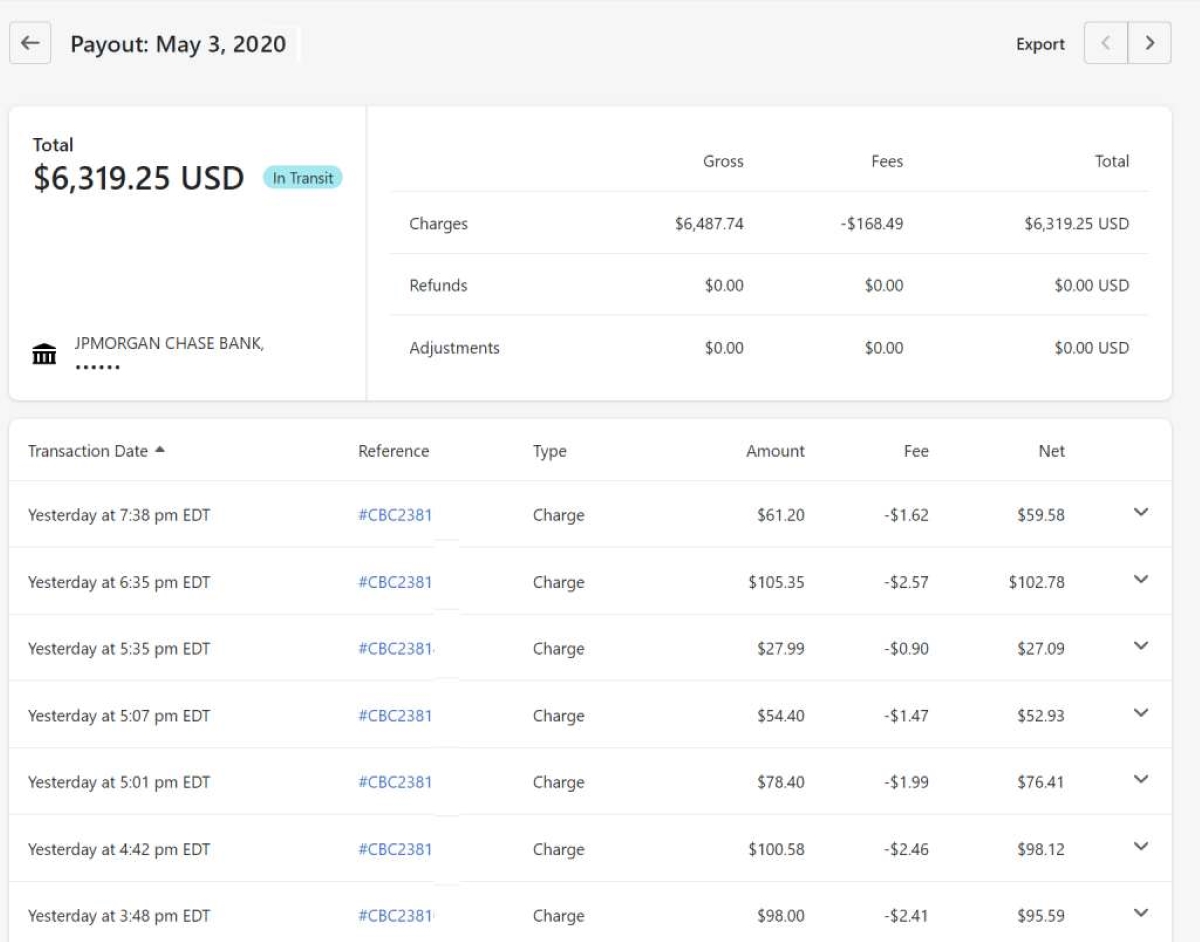

Finance
How To Do Credit Checks On Customers
Modified: January 10, 2024
Learn how to conduct credit checks on customers in the finance industry to minimize risks and make informed decisions. Gain insights on evaluating creditworthiness and protecting your business
(Many of the links in this article redirect to a specific reviewed product. Your purchase of these products through affiliate links helps to generate commission for LiveWell, at no extra cost. Learn more)
Table of Contents
- Introduction
- Why Credit Checks Are Important for Businesses
- Factors to Consider Before Conducting a Credit Check
- Legal Considerations for Conducting Credit Checks
- Step-by-Step Guide on How to Do Credit Checks on Customers
- Alternative Methods for Assessing Creditworthiness
- Benefits of Regularly Conducting Credit Checks
- Best Practices for Credit Check Procedures
- Conclusion
Introduction
Welcome to our comprehensive guide on how to do credit checks on customers. In today’s fast-paced and highly competitive business world, it’s crucial for companies to make informed decisions when extending credit to customers. Conducting thorough credit checks allows businesses to assess the financial stability and creditworthiness of potential clients, mitigating the risk of non-payment and financial losses.
Whether you’re a small business owner or part of a larger organization, understanding the importance of credit checks and how to perform them efficiently is essential. This article will provide you with valuable insights and step-by-step guidance on conducting credit checks on customers, along with alternative methods for assessing creditworthiness. Additionally, we’ll explore the legal considerations and best practices associated with credit check procedures to ensure compliance and accuracy.
By implementing effective credit check procedures, you can make better-informed decisions, improve cash flow management, and protect your business from risks associated with non-payment. So, let’s dive in and explore the world of credit checks!
Why Credit Checks Are Important for Businesses
Credit checks play a vital role in safeguarding the financial wellbeing of businesses. They provide crucial information about a customer’s creditworthiness and potential risks associated with extending credit. Here are some key reasons why credit checks are important:
- Risk Mitigation: Credit checks allow businesses to assess the risk of non-payment by potential customers. By analyzing a customer’s credit history, payment patterns, and financial stability, businesses can make informed decisions about extending credit and set appropriate credit limits. This helps reduce the risk of bad debt and financial losses.
- Cash Flow Management: Timely payment is essential for maintaining healthy cash flow. Conducting credit checks helps businesses identify customers with a history of late payments or defaulting on their obligations. By avoiding customers with poor credit records, businesses can maintain a steady cash flow and allocate resources more efficiently.
- Customer Selection: Credit checks enable businesses to select the right customers to work with. By identifying customers with a strong credit history and a track record of timely payments, businesses can build long-term relationships with reliable clients. This not only reduces the risk of non-payment but also enhances the overall customer experience.
- Negotiating Power: Understanding a customer’s creditworthiness provides businesses with valuable leverage during negotiations. Armed with knowledge about a customer’s financial stability, businesses can negotiate favorable terms, such as shorter payment terms or higher credit limits. This empowers businesses to establish mutually beneficial agreements that align with their financial goals.
- Legal Protection: Performing credit checks helps businesses comply with legal requirements and reduce the risk of engaging with customers involved in fraudulent activities or financial misconduct. By conducting due diligence, businesses can protect themselves from potential legal and reputational issues.
In summary, credit checks are crucial for businesses to assess the financial risk associated with extending credit. By conducting thorough credit checks, businesses can mitigate risks, manage cash flow effectively, select reliable customers, negotiate better terms, and ensure legal compliance. The next section will delve into the factors businesses should consider before conducting a credit check on a potential customer.
Factors to Consider Before Conducting a Credit Check
Before conducting a credit check on a potential customer, there are several important factors that businesses should consider. By taking these factors into account, businesses can ensure that they are making informed decisions and allocating their resources effectively. Here are the key factors to consider:
- Industry and Customer Type: Different industries and customer types have varying levels of risk associated with them. Before conducting a credit check, it’s essential to understand the specific characteristics and risks of the industry and customer segment you are dealing with. For example, customers in sectors like healthcare or construction tend to have longer payment cycles, which may impact their creditworthiness.
- Credit Terms: The credit terms offered to customers can have a significant impact on their creditworthiness. Evaluate the payment terms and credit limits you are willing to offer and assess the potential risks associated with them. Consider factors such as the size of the credit line, payment frequency, and any late payment penalties.
- Financial Information: Gathering and analyzing financial information about a potential customer is critical in assessing their creditworthiness. This includes reviewing their financial statements, bank references, and trade references. Look for indicators of financial stability, such as a healthy cash flow, positive net worth, and consistent profitability.
- Credit History and Payment Patterns: Examining a customer’s credit history and payment patterns provides valuable insights into their ability to meet financial obligations. Look for any late payments, defaults, or bankruptcies that may indicate a higher risk of non-payment. Analyze trends and the length of the credit history to gauge the customer’s reliability.
- Customer Relationships: Consider the nature and history of the customer relationship. Have they been a consistent customer in the past? Have they demonstrated loyalty and reliability? Previous interactions and feedback from other businesses can provide valuable information on the customer’s payment behavior and overall creditworthiness.
By carefully considering these factors before conducting a credit check, businesses can gain a better understanding of the potential risks and make informed decisions about extending credit. In the next section, we will explore the legal considerations that businesses should be aware of when conducting credit checks.
Legal Considerations for Conducting Credit Checks
When conducting credit checks on customers, it’s essential for businesses to be aware of and comply with legal requirements. Here are some key legal considerations to keep in mind:
- Obtaining Consent: Before performing a credit check, it’s crucial to obtain the customer’s consent. This consent should be in writing and clearly state the purpose of the credit check. Businesses should also ensure that they comply with any applicable data protection and privacy laws, such as the General Data Protection Regulation (GDPR) in the European Union or the California Consumer Privacy Act (CCPA) in the United States.
- Using Credit Reporting Agencies: If your business uses credit reporting agencies to obtain credit reports, it’s important to comply with the terms and conditions of those agencies. Familiarize yourself with the legal requirements and restrictions imposed by credit reporting agencies, such as permissible purposes for accessing credit reports and data retention policies.
- Anti-Discrimination Laws: Businesses must ensure that their credit check procedures do not violate anti-discrimination laws. It’s important to treat all customers equally and avoid basing credit decisions on factors such as race, gender, age, or disability. Familiarize yourself with the applicable anti-discrimination laws and guidelines in your jurisdiction, such as the Equal Credit Opportunity Act (ECOA) in the United States.
- Data Security: Safeguarding the customer’s personal and financial information is crucial. Businesses must take appropriate measures to protect customer data and comply with data protection laws. This includes implementing secure protocols for storing and transmitting sensitive information, limiting access to authorized personnel, and regularly updating security measures to mitigate the risk of data breaches.
- Compliance with Consumer Rights: Businesses should be aware of the consumer rights related to credit checks. For example, customers have the right to request a copy of their credit report and dispute any inaccuracies. Familiarize yourself with the rights and obligations of both businesses and customers under relevant consumer protection laws, such as the Fair Credit Reporting Act (FCRA) in the United States.
It’s important to consult with legal professionals or credit experts to ensure that your credit check procedures comply with the specific laws and regulations in your jurisdiction. By adhering to legal requirements, businesses can protect themselves from potential legal disputes and reputational damage. In the next section, we’ll provide a step-by-step guide on how to perform credit checks on customers.
Step-by-Step Guide on How to Do Credit Checks on Customers
Performing credit checks on customers involves a systematic process to gather and evaluate relevant information. Follow these step-by-step guidelines to effectively conduct credit checks:
- Collect Customer Information: Start by collecting the necessary information from the customer, including their legal name, contact information, and any relevant identification numbers, such as their social security number or business tax ID. This information will be needed to retrieve credit reports and other financial data.
- Obtain Written Consent: Before proceeding with the credit check, ensure that you have obtained written consent from the customer. The consent should include the purpose of the credit check and comply with data protection and privacy laws. Maintain a copy of the consent for record-keeping purposes.
- Access Credit Reports: Depending on your location and available resources, you may access credit reports from credit reporting agencies. Obtain the necessary authorization and follow the required procedures to retrieve credit reports for the customer. These reports provide valuable information on the customer’s credit history, payment patterns, and financial stability.
- Analyze Credit Reports: Review the credit reports carefully, looking for key indicators of creditworthiness, such as the customer’s payment history, credit utilization, and any negative marks, such as late payments or collections. Assess the customer’s credit score and evaluate it in the context of your business’s credit risk tolerance.
- Check Trade References: Contact the customer’s trade references to gather additional insights into their payment behavior. These references may include suppliers, lenders, or other businesses with which the customer has a history of financial transactions. Inquire about the customer’s payment history, creditworthiness, and any issues encountered in dealing with them.
- Consider Additional Information: In addition to credit reports and trade references, consider gathering additional information about the customer. This may include reviewing financial statements, conducting a background check, or assessing their industry reputation. This extra information can provide a more holistic view of the customer’s creditworthiness.
- Evaluate Creditworthiness: Based on the information gathered, evaluate the customer’s creditworthiness. Consider factors such as their credit history, payment patterns, financial stability, and any red flags discovered during the credit check process. Use your business’s predetermined criteria to assess the risk associated with extending credit to this customer.
- Set Credit Terms: Once you have assessed the customer’s creditworthiness, determine the appropriate credit terms to offer. This includes establishing a credit limit, payment terms, and any relevant conditions or requirements. Ensure that the credit terms align with your business’s risk appetite and financial objectives.
- Communicate Credit Decision: Finally, communicate the credit decision to the customer. Whether approving or denying credit, provide clear and concise reasoning for your decision. If credit is approved, clearly outline the approved credit terms and any additional steps the customer needs to take.
Following this step-by-step guide will help you conduct thorough credit checks and make informed decisions when extending credit to customers. However, keep in mind that credit checks are not a one-time event. Regularly monitoring the creditworthiness of existing customers is equally important to manage ongoing credit risks. In the next section, we will explore alternative methods for assessing creditworthiness.
Alternative Methods for Assessing Creditworthiness
While credit checks are a traditional and reliable method for assessing creditworthiness, there are alternative methods that businesses can consider to supplement or enhance the credit evaluation process. These alternative methods can provide additional insights into a customer’s financial health and help businesses make informed credit decisions. Here are some alternative methods for assessing creditworthiness:
- Bank Reference: Requesting a bank reference from the customer allows businesses to gather information about the customer’s banking relationship and history. This can include details about the customer’s average balances, overdrafts, and any past issues with payments or bounced checks.
- Trade References: In addition to contacting trade references provided by the customer, businesses can also reach out to other suppliers or partners in the industry to gather information about the customer’s payment behavior and creditworthiness. These references can provide valuable insights from third-party perspectives.
- Customer Financial Statements: For larger customers or those with a longer business history, requesting their financial statements can provide a clearer picture of their financial health. Analyzing their financial statements, such as balance sheets, income statements, and cash flow statements, can help gauge their profitability, liquidity, and overall financial stability.
- Industry Credit Indices: Some industries have established credit indices or databases that aggregate credit information about businesses within that specific sector. Accessing and analyzing these indices can provide industry-specific credit benchmarks and help businesses compare a customer’s creditworthiness to others within the same industry.
- Collateral or Security: In certain cases, businesses may require customers to provide collateral or security against the credit they are being offered. This can be in the form of assets, such as property or equipment, that the business can claim in the event of non-payment. Assessing the value and quality of the collateral can help mitigate credit risk.
- Payment Histories: Analyzing payment histories can provide valuable insights into a customer’s past payment behavior. This can involve reviewing their payment records with other businesses, assessing their promptness in settling invoices, and verifying their ability to meet payment deadlines.
By incorporating these alternative methods into your credit evaluation process, you can gain a more comprehensive understanding of a customer’s creditworthiness. It’s important to note that these methods should not replace credit checks but rather supplement them to enhance decision-making. Each business should determine which alternative methods are most relevant and effective in their industry and specific customer segment.
In the next section, we will explore the benefits of regularly conducting credit checks on customers.
Benefits of Regularly Conducting Credit Checks
Regularly conducting credit checks on customers is a proactive approach that offers numerous benefits to businesses. By consistently assessing the creditworthiness of customers, businesses can mitigate risks, maintain healthy cash flow, and make informed decisions. Here are some key benefits of regularly conducting credit checks:
- Risk Mitigation: Regular credit checks allow businesses to continuously monitor the financial health of their customers. By identifying any changes in creditworthiness or potential risks, businesses can take appropriate measures to mitigate the risk of non-payment and bad debt. This helps safeguard their financial stability.
- Improved Cash Flow Management: Timely payment is crucial for maintaining a healthy cash flow. Regular credit checks enable businesses to identify customers who may be experiencing financial difficulties or displaying deteriorating payment patterns. By addressing these concerns early on, businesses can avoid cash flow disruptions and allocate resources effectively.
- Identifying Opportunities and Risks: Regular credit checks can provide businesses with valuable insights into their customer base. By identifying customers with strong creditworthiness, businesses can offer them more favorable terms and build long-term relationships. Conversely, businesses can also identify customers whose creditworthiness may have declined, allowing them to adjust credit limits or take other proactive measures.
- More Informed Credit Decisions: Conducting credit checks on a regular basis ensures that businesses can make well-informed credit decisions. By continuously evaluating a customer’s creditworthiness, businesses can adjust credit terms, reassess credit limits, and take appropriate actions to protect their interests.
- Customer Relationship Management: Regular credit checks facilitate effective customer relationship management. Businesses can proactively communicate with customers regarding their credit status, address any concerns, and provide guidance to improve their creditworthiness. This fosters transparency and trust in the business relationship, leading to better customer satisfaction and loyalty.
- Compliance with Regulatory Requirements: Depending on the industry and jurisdiction, businesses may have legal obligations to regularly assess the creditworthiness of their customers. Regular credit checks ensure compliance with these regulatory requirements, reducing the risk of legal issues or penalties.
Regularly conducting credit checks is a proactive approach that enables businesses to stay ahead of potential credit risks and make well-informed decisions. By maintaining an ongoing assessment of customer creditworthiness, businesses can mitigate risks, improve cash flow management, identify opportunities, and foster stronger customer relationships. In the final section, we will explore some best practices for credit check procedures.
Best Practices for Credit Check Procedures
Implementing best practices for credit check procedures can enhance the effectiveness and accuracy of the credit evaluation process. By following these guidelines, businesses can conduct credit checks efficiently and make informed decisions. Here are some best practices for credit check procedures:
- Establish Clear Credit Policies: Develop clear and comprehensive credit policies that outline your business’s credit evaluation criteria, credit terms, and procedures. Ensure that all employees involved in the credit check process are familiar with these policies and adhere to them consistently.
- Use Reliable Data Sources: Rely on reputable credit reporting agencies and data providers when gathering information for credit checks. Verify the accuracy and reliability of the data to ensure informed decision-making. Regularly review and update the data sources to access the most up-to-date information.
- Maintain Confidentiality: Handle customer information with utmost confidentiality and safeguard it against unauthorized access. Establish strict protocols for data protection and educate employees on the importance of maintaining customer privacy. Comply with applicable data protection laws and industry regulations.
- Develop Consistent Evaluation Criteria: Establish consistent criteria for evaluating creditworthiness. This includes factors such as credit history, payment patterns, financial stability, and industry-specific considerations. These criteria should be applied consistently to all customers to ensure fairness and objective decision-making.
- Perform Regular Credit Reviews: Conduct regular reviews of customers’ creditworthiness to ensure ongoing monitoring. Update credit reports, reassess payment histories, and evaluate any changes that may impact a customer’s creditworthiness. This allows businesses to respond promptly to any emerging risks or opportunities.
- Document Credit Decisions: Maintain accurate records of credit decisions, including the rationale behind approving or denying credit and any conditions or adjustments made. This documentation serves as evidence of due diligence and helps in addressing future inquiries or disputes.
- Continuously Educate and Train Employees: Keep your employees updated on changes in credit check procedures, legal requirements, and industry best practices. Provide training to employees involved in the credit check process to ensure they are equipped with the necessary knowledge and skills to perform their tasks effectively.
- Regularly Review and Improve Procedures: Continuously evaluate and improve your credit check procedures based on feedback, industry advancements, and changing business needs. Regularly assess the effectiveness of your credit policies and identify areas for improvement to enhance the accuracy and efficiency of the credit evaluation process.
By adopting these best practices, businesses can establish robust credit check procedures that protect their interests, ensure compliance, and improve decision-making. Remember, regularly reviewing and refining your credit check procedures is key to adapting to changing business dynamics and maintaining a proactive approach to credit risk management.
Now that you have a solid understanding of credit checks, legal considerations, and best practices, you are better equipped to make informed credit decisions and safeguard your business’s financial health.
If you have any further questions or need assistance with credit check implementation, feel free to consult with credit experts or legal professionals to ensure compliance with specific industry and jurisdictional requirements.
Conclusion
Credit checks are an essential tool for businesses to assess the creditworthiness of customers and make informed decisions about extending credit. By conducting thorough credit checks, businesses can mitigate the risk of non-payment, improve cash flow management, and build stronger customer relationships.
This comprehensive guide has provided valuable insights and step-by-step guidance on how to conduct credit checks on customers. We explored the importance of credit checks, factors to consider before conducting them, legal considerations, alternative assessment methods, benefits of regular credit checks, and best practices for credit check procedures.
It’s crucial to remember that credit checks should not be a one-time event. Regularly monitoring the creditworthiness of existing customers is equally important to manage ongoing credit risks. By continually evaluating and adjusting credit limits, terms, and conditions, businesses can proactively protect themselves from potential non-payment and financial losses.
Additionally, businesses should always ensure compliance with legal requirements and industry-specific regulations when conducting credit checks. Obtaining proper consent, handling and protecting customer data securely, and adhering to anti-discrimination laws are vital considerations to avoid legal issues and protect customer privacy.
Remember, credit checks are just one part of the overall credit evaluation process. Combining credit checks with other methods, such as assessing trade references, customer financial statements, and industry credit indices, can provide a more comprehensive understanding of a customer’s creditworthiness.
By implementing best practices, such as establishing clear credit policies, using reliable data sources, and maintaining confidentiality, businesses can optimize their credit check procedures and make informed credit decisions.
In conclusion, conducting credit checks on customers is crucial for businesses of all sizes and industries. By following the guidelines and recommendations provided in this guide, businesses can effectively assess creditworthiness, mitigate risks, and protect their financial stability in an ever-changing business landscape.
Remember, credit checks are a proactive approach to credit risk management, allowing businesses to make informed decisions and build successful, long-term relationships with reliable customers.














